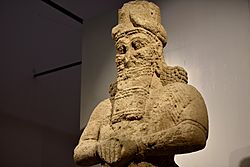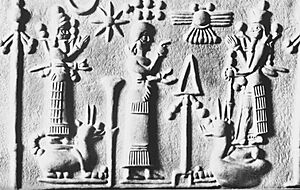Nabu facts for kids
Quick facts for kids Nabû |
|
|---|---|
| God of literacy, the rational arts, scribes and wisdom | |

Colossal statue of the god Nabu, 8th century BC, from Nimrud, on display in the National Museum of Iraq
|
|
| Abode | Borsippa |
| Planet | Mercury |
| Symbol | Clay tablet and stylus |
| Consort | Tashmet |
| Parents | Marduk and Sarpanitum |
| Equivalents | |
| Greek equivalent | Hermes |
| Roman equivalent | Mercury |
| Egyptian equivalent | Thoth |
Nabu was an important god in ancient Mesopotamia. He was known as the god of literacy (reading and writing), wisdom, and the arts. He was also the special protector of scribes, who were people who wrote things down.
Contents
Who Was Nabu?
Nabu was worshipped by people in ancient Babylon and Assyria. He became very important to the Babylonians around 1000 BCE. They believed he was the son of the great god Marduk.

Nabu's main city for worship was Borsippa. This city was like a sister city to Babylon. Every year, during the New Year festival, Nabu's statue was carried from Borsippa to Babylon. This was so he could visit his father, Marduk.
Nabu's symbols were a stylus (a writing tool) resting on a clay tablet. Sometimes, his symbol was just a simple wedge shape. King Nabonidus, whose name means "Nabu is exalted," even had a royal scepter with Nabu's wedge on top. People would offer clay tablets with beautiful writing to Nabu's temple. His wife was the goddess Tashmet.
Nabu's Powers and Role
Nabu was seen as the inventor of writing. He was also a divine scribe, meaning a god who wrote things down. People believed he wrote down the fates of humans. He was sometimes linked with the scribe god Ninurta.
As a god of wisdom, Nabu was also connected to oracles. Oracles were people who could tell the future or give advice from the gods. He was also associated with the Mesopotamian moon god Sin.
Nabu was often shown wearing a horned cap. He stood with his hands clasped, which was a traditional pose for priests. He rode on a winged dragon called Sirrush. This dragon originally belonged to his father, Marduk. In Babylonian astrology, Nabu was linked to the planet Mercury.
People continued to worship Nabu for a very long time. His worship lasted until about the 2nd century CE. This was when Cuneiform writing, the ancient writing system, was no longer used.
Nabu's Influence Beyond Mesopotamia
Nabu's worship spread outside of Mesopotamia. His cult (a group of followers) reached ancient Egypt. He was one of five non-Egyptian gods worshipped in a place called Elephantine.
Nabu is also mentioned in the Bible. He appears as "Nebo" in the books of Isaiah and Jeremiah.
During the Hellenistic period, Nabu was sometimes connected to the Greek god Apollo. This was because both were seen as givers of prophecies. Since Nabu was a god of wisdom and a divine messenger, he was also linked to other gods. These included the Greek god Hermes, the Roman god Mercury, and the Egyptian god Thoth.
Related pages
See also
 In Spanish: Nabu para niños
In Spanish: Nabu para niños

